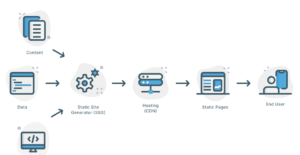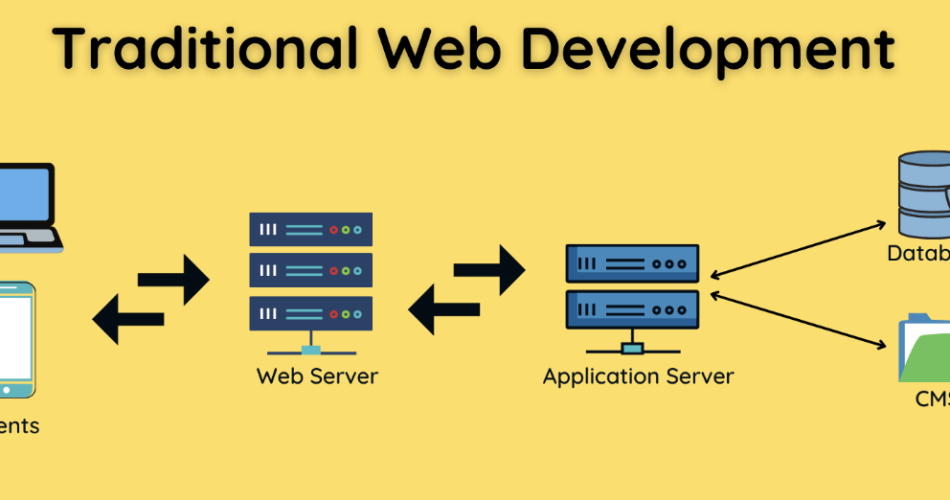Static site generators are powerful tools that have revolutionized the way websites are built and deployed. Unlike traditional dynamic websites that rely on server-side processing, static site generators create pre-rendered HTML pages that can be served directly from a content delivery network (CDN) or a web server. This approach offers a range of benefits, including improved performance, enhanced security, and easier maintenance.

static site generators
At their core, static site generators work by converting content, typically written in Markdown or other lightweight markup languages, into static HTML pages. These pages are then deployed to a hosting platform, where they can be served quickly and efficiently to users. This process eliminates the need for server-side processing, reducing the complexity and overhead associated with traditional web applications.
Contents
- 1 Advantages of using static site generators
- 2 Popular static site generator options
- 3 Key features and capabilities of static site generators
- 4 How static site generators improve website performance
- 5 Customization and flexibility with static site generators
- 6 SEO benefits of static site generators
- 7 Steps to build a website using a static site generator
- 8 Case studies of successful websites built with static site generators
- 9 Conclusion
Advantages of using static site generators
- Performance Optimization: Static site generators produce highly optimized websites that load quickly, providing a seamless user experience. By serving pre-rendered HTML pages, the need for server-side processing is eliminated, resulting in faster load times and improved responsiveness.
- Enhanced Security: Static websites are less vulnerable to security threats, as they do not rely on server-side scripts or databases that could be exploited. This makes them an attractive choice for websites that handle sensitive information or require a high level of security.
- Scalability and Reliability: Static site generators enable websites to scale effortlessly, as the hosting infrastructure can be easily replicated and distributed across multiple servers or CDN networks. This ensures high availability and reliability, even during periods of high traffic.
- Simplified Development and Deployment: The development process for static sites is often more straightforward, as developers can focus on content creation and site structure rather than complex server-side configurations. Deployment is also simplified, as static files can be easily uploaded or pushed to a hosting platform.
- Cost-Effective: Hosting static websites is generally more cost-effective than maintaining dynamic web applications, as the hosting requirements are typically lower, and the need for server-side infrastructure is reduced.
Popular static site generator options
There are several popular static site generators available, each with its own unique features and capabilities. Some of the most widely used options include:
- Jekyll: A Ruby-based static site generator that is widely used for building blogs and personal websites. It offers a simple and intuitive interface, as well as a large ecosystem of plugins and themes.
- Hugo: A fast and flexible static site generator written in Go. Hugo is known for its exceptional performance and ease of use, making it a popular choice for a wide range of website projects.
- Gatsby: A React-based static site generator that is particularly well-suited for building modern, feature-rich websites and web applications. Gatsby leverages the power of React and GraphQL to provide a robust and extensible platform.
- Next.js: A React framework that combines the benefits of static site generation with server-side rendering and client-side hydration. Next.js is a popular choice for building complex web applications with dynamic content.
- Eleventy: A versatile static site generator that supports a wide range of input formats, including Markdown, HTML, and JavaScript. Eleventy is known for its simplicity and flexibility, making it a great choice for a wide range of website projects.
Key features and capabilities of static site generators
Static site generators offer a range of features and capabilities that make them a powerful choice for building modern, high-performing websites. Some of the key features include:
- Content Management: Most static site generators provide robust content management capabilities, allowing users to write and organize content using Markdown, YAML, or other lightweight markup languages.
- Templating and Theming: Static site generators typically include powerful templating engines that enable developers to create reusable layouts, components, and themes, streamlining the development process.
- Automated Build and Deployment: Static site generators often include built-in tools for automating the build and deployment process, making it easy to publish updates and new content.
- Plugin Ecosystem: Many static site generators have thriving plugin ecosystems, providing a wide range of functionality and extensions to enhance the capabilities of the platform.
- Multilingual Support: Some static site generators offer built-in support for multilingual content, making it easier to create websites that cater to a global audience.
- Progressive Web App (PWA) Integration: Static site generators can be easily integrated with PWA technologies, enabling the creation of fast, reliable, and engaging web experiences that work seamlessly across devices.
How static site generators improve website performance
One of the primary advantages of using static site generators is their ability to deliver exceptional website performance. By pre-rendering content into static HTML files, static site generators eliminate the need for server-side processing, reducing the time and resources required to serve each page.
This performance optimization is further enhanced by the ability to leverage content delivery networks (CDNs) and caching mechanisms. Static files can be easily cached and distributed across a global network of servers, ensuring that users can access the content quickly, regardless of their location.
Additionally, static site generators often include built-in optimizations, such as image compression, script minification, and HTML/CSS/JavaScript bundling, further improving the overall speed and responsiveness of the website.
Customization and flexibility with static site generators
Despite their simplicity, static site generators offer a high degree of customization and flexibility. Developers can choose from a wide range of generators, each with its own set of features, plugins, and ecosystem support.
This flexibility extends to the development workflow as well. Static site generators can be easily integrated with popular version control systems, such as Git, enabling seamless collaboration and version control. Additionally, many static site generators support a range of content formats, including Markdown, HTML, and even custom data sources, allowing developers to tailor the content management process to their specific needs.
Furthermore, static site generators often provide robust theming and templating capabilities, enabling designers and developers to create unique and visually appealing websites that align with their brand and design preferences.
SEO benefits of static site generators
Static site generators offer several advantages when it comes to search engine optimization (SEO). By generating pre-rendered HTML pages, static sites are inherently more SEO-friendly than their dynamic counterparts.
One of the key benefits is the improved page load times. Search engines, such as Google, prioritize fast-loading websites in their ranking algorithms, as they provide a better user experience. Static site generators, with their optimized asset delivery and reduced server-side processing, can significantly improve a website’s page speed, leading to higher search engine rankings.
Additionally, static site generators often include built-in support for features like meta tags, sitemaps, and schema markup, which are essential for effective SEO. These features make it easier for search engines to crawl, index, and understand the content of the website, improving its visibility and discoverability in search engine results.
Steps to build a website using a static site generator
Building a website with a static site generator typically involves the following steps:
- Choose a Static Site Generator: Select the static site generator that best fits your project requirements, taking into account factors such as development language, ecosystem, and feature set.
- Set up the Development Environment: Install the necessary dependencies and configure the development environment for the chosen static site generator.
- Create Content: Write and organize your website’s content using Markdown or other supported formats.
- Design and Develop the Site: Leverage the generator’s templating system and theming capabilities to create the visual design and layout of your website.
- Customize and Extend: Explore the available plugins and extensions to add additional functionality, such as forms, e-commerce, or analytics.
- Test and Optimize: Thoroughly test the website for performance, accessibility, and cross-browser compatibility, making necessary optimizations.
- Automate the Build and Deployment: Set up a continuous integration and deployment workflow to streamline the publishing process.
- Deploy to a Hosting Platform: Choose a suitable hosting platform, such as GitHub Pages, Netlify, or a cloud-based hosting service, and deploy your static website.
Case studies of successful websites built with static site generators
- The Verge: The popular tech news and media website, The Verge, uses Gatsby, a React-based static site generator, to power its online presence. The Verge’s website is known for its fast load times, responsive design, and seamless user experience, all of which are facilitated by the use of a static site generator.
- Smashing Magazine: Smashing Magazine, a renowned web design and development publication, has transitioned to using Hugo, a fast and flexible static site generator. This change has allowed Smashing Magazine to improve its website’s performance, streamline its content management, and enhance the overall user experience.
- Forestry.io: Forestry.io, a content management platform, has built its own website using Jekyll, a popular static site generator. By leveraging Jekyll’s simplicity and flexibility, Forestry.io has created a fast, secure, and easily maintainable website that showcases its product and services.
- Netlify: Netlify, a leading static site hosting and deployment platform, uses Eleventy, a versatile static site generator, to power its own website. This choice aligns with Netlify’s mission to promote and support the use of static site technologies.
- Basecamp: Basecamp, a project management and team communication tool, has embraced static site generation by using Hugo to build its marketing website. This approach has enabled Basecamp to deliver a lightning-fast, highly optimized online presence that complements its product offerings.
Conclusion
In the ever-evolving landscape of web development, static site generators have emerged as a game-changing technology that offers a powerful and straightforward approach to building modern, high-performing websites. By leveraging the advantages of pre-rendered HTML, static site generators provide improved performance, enhanced security, and simplified development and deployment.
As the demand for fast, reliable, and scalable web experiences continues to grow, the adoption of static site generators is on the rise. Businesses and individuals alike are recognizing the transformative potential of these tools, using them to create visually appealing, SEO-friendly, and highly customizable websites that meet the needs of their target audiences.
If you’re ready to unleash the power and simplicity of static site generators for your website, consider exploring the various options available and start building your next project with the confidence that comes from leveraging these cutting-edge technologies. Take the first step towards a faster, more secure, and more efficient online presence today.
